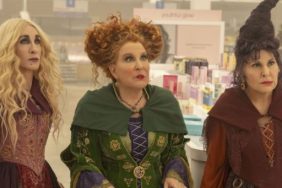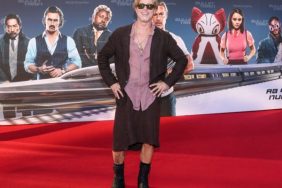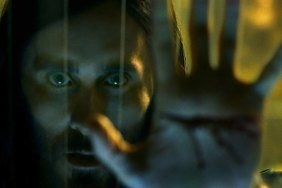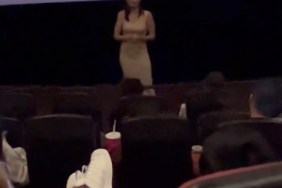When I called Andrew Davis for our interview, he said, “Hi, this is Andy.” So not only are we on a first name basis, but I get to call him Andy. He also asked me to e-mail him, so to my teenage self watching The Fugitive that summer in 1993, you now have a direct line to the director of The Fugitive.
Warner Home Video is putting out a 20th Anniversary Blu-ray and DVD of the film in which Harrison Ford played Dr. Richard Kimble, framed for his wife’s murder by a one-armed man and on the run from U.S. Marshall Sam Gerard (Tommy Lee Jones). Davis has also directed films from Code of Silence and Above the Law to Under Siege, Collateral Damage and The Guardian. Spoilers for The Fugitive follow, so if you are a new audience we highly recommend you watch the 20th Anniversary of The Fugitive and then read our interview with Andy Davis.
CraveOnline: I understand you are responsible for the bearded Indiana Jones we saw on that episode of “The Young Indiana Jones Chronicles.”
Andrew Davis: I am responsible?
Well, he had a beard because he was shooting The Fugitive at the time, right?
[Laughs] Well, I would think that Harrison’s mother and father are responsible for the beard, but it was an interesting issue because Bob Daly, the head of the studio, didn’t want him to have that beard too long. If you look at the making of the movie on the new DVD/Blu-ray, I think Harrison talks about the fact that he said, “Well, if I start without a beard I’m going to have to grow one in order to be hidden.” We wound up shaving it shortly after we started shooting.
I’d forgotten that he also dyes his hair too.
Yeah, yeah.
Do you ever wish you had CGI for the train crash, or are you glad that wasn’t available so they couldn’t force you to use it?
I’m glad it wasn’t available because not only was the train crash very effective because you really felt it and saw it, but the next day when the marshals show up and there’s aerials of it, that would’ve been a nightmare to try and put all that in digitally and have people reacting to nothingness.
And it’s old school compositing with miniatures?
There’s only one cut of a miniature which is the uncoupling. I think 95% of it is the real thing. There were some plates shot with cameras that were buried in the ground that were used with Introvision, rear projection but all of those images are real images. They were not done by miniatures.
And it looks so seamless. Why do technicians insist on using computers now and think it look better?
I think that people don’t think creatively about what the pros and cons are sometimes. Certainly in terms of danger, it’s better not to have a train flying around with thirteen cameras there, but we were very cautious and nobody was near it so couldn’t get hurt. It’s an amazing thing because I think it’s affected the way people feel about movies. People feel like “Well, that person’s not really in jeopardy because it’s all done on a computer. That guy’s really not on that car chasing that guy that fast” which I think is good and healthy that stuntmen aren’t getting hurt. They can still make a living but people really felt that he was in jeopardy getting off that bus when that train was coming. I think today maybe they’re numbed to that kind of stuff because of knowing it’s all done in a box.
The Fugitive was an enormous hit but 20 years later, when Spielberg and Lucas talk about the Hollywood implosion, The Fugitive is the kind of movie they’re not making anymore. Except for the train crash and the jump off the damn, it’s not a lot of huge spectacle. It’s mostly people running.
It’s a thriller, it’s a drama, it’s a mystery. There are a lot of other elements going on and it’s basically character driven. You care about Dr. Kimble because you believe he was really framed and there are some really bad people involved in setting him up. We’ve gotten into the world of eye candy and into the world where if it doesn’t have tons of eye candy where a 22-year-old in some other country can just enjoy watching it, then they hardly get made. It’s too bad because if you look at the numbers of The Fugitive, in today’s numbers it’s a billion dollar movie.
At the same time, they don’t know how to sell that movie or they’re not willing to take a chance to sell an American doctor story around the world. Now, Harrison was the biggest movie star in the world almost when we made that movie. Today there aren’t too many movie stars. It’s all about the movie, not the star.
Twenty years later, were there any stories about The Fugitive you hadn’t told yet that could go in that new behind the scenes documentary?
One of the stories that didn’t get in there was how the script evolved. When I was given the script, I was hired right after the premiere of Under Siege. Arnold Kopelson saw it and said, “I’ve got to show this to Harrison Ford.” He did and I got a call from the studio that Sunday that they wanted me to meet Harrison. He approved me as the director. In the script that I got, the one-armed man had been hired by the Gerard character, by the marshall, because Kimble had screwed up on the operating table on his wife. It was ridiculous.
Harrison committed to making this movie. How am I going to fix this? So I called my sister who was a nurse and I said, “Josie, we’ve got to figure out how to get a doctor in lots of trouble.” She went back to the hospital at Cedars Sinai and came back a couple days later with some input from some doctor friends and said, “Well, what if there’s drug protocol going on and a guy said, ‘It’s poison. It’s killing people. They’re bleeding.’” It became Devlin MacGregor which is ‘The Devil In MacGregor’ from Peter Macgregor-Scott, that’s how we came up with the name. It was called Provasic which was something that was going to clean out your arteries.
That became the whole basis of this pharmacy conspiracy and I think that really resounds today. It’s so true. It’s been going on. There’ve been books written. I’ve been asked to actually write comments on books about problems between drugs and Johnson & Johnson and some big firms that were involved. It’s very relevant in terms of the corporate greed involved in setting up the thriller.
I also feel, what I really appreciated seeing it recently again, was the Chicagoese of it. I’m from Chicago, I’ve made a lot of films in Chicago. It really captures the city in a wonderful way in terms of its casting and the way people sound and act. It sort of opened the doors to Chicago as a huge production center. “ER” was based upon a lot of what The Fugitive looked like. Batman [The Dark Knight] and all those other movies that shot in Chicago and produced by Warners were there because they had such great experience from the cooperation we got.









